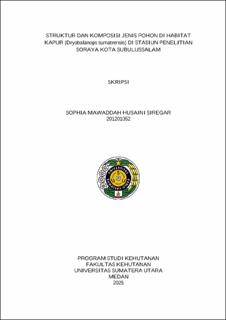Struktur dan Komposisi Jenis Pohon di Habitat Kapur (Dryobalanops Sumatrensis) di Stasiun Penelitian Soraya Kota Subulussalam
Structure and Composition of Tree Species in Kapur (Dryobalanops sumatrensis) Habitat at Soraya Research Station, Subulussalam City

Date
2025Author
Siregar, Sophia Mawaddah Husaini
Advisor(s)
Susilowati, Arida
Elfiati, Deni
Metadata
Show full item recordAbstract
The Soraya Research Station is a conservation area that has a very high level of diversity. As one of the conservation areas, the existence of the Soraya Research Station is very important in the context of biodiversity protection. The purpose of the study was to analyze species diversity, species associations, and species regeneration status in kapur habitats (Dryobalanops sumatrensis) at the Soraya Research Station. The study was conducted using a purposive sampling technique to observe 18 research plots from a total area of 14.5 ha, with a sampling intensity of 5%. The highest Important Value Index (INP) at the seedling and stake level was obtained by D. sumatrensis and Glochidion glomerulatum, which were 39.04% and 28.91%. At the level of poles and trees, the highest INP was obtained by D. sumatrensis, which was 32.36% and 55.09%. D. sumatrensis associations are found at the seedling, sapling, pole, and tree stage. The species associated with D. sumatrensis at the seedling stagel are 14 types, 28 types of sapling, 44 types of poles, and 60 types of trees. A total of 125 species with different regeneration conditions were found. A total of 39.68% (50 species) have new regeneration status, 46.03% (58 species) have poor regeneration status, 1.56% (2 species) have good status, 8.73% (11 species) have non-regeneration status and 4 species (3.17%) have adequate regeneration status. Based on these findings, conservation efforts are urgently needed in this location because of the challenges in the regeneration process.
Collections
- Undergraduate Theses [2162]
